Ford Ranger PHEV Review 2025
Ford Ranger PHEV At A Glance
Expect to see a few more vehicles similar to the Ford Ranger PHEV within the next couple of years, although right now it's the only plug-in hybrid pickup on sale.
Prompting the expected surge in demand are changes to benefit-in-kind (BiK) taxation which removed one of the main reasons many people bought pickup trucks for. Double-cab pickups are now treated as cars from a BiK perspective, meaning they’re selling in smaller numbers than before. The Ford Ranger PHEV is set to change all that.
In place of the 2.0- and 3.0-litre diesel engines that power the more traditional versions of the Ford Ranger, the PHEV has a 2.3-litre EcoBoost turbocharged petrol engine and electric motor combination, matched to a 10-speed automatic transmission.
We expect the same arrangement to make an imminent appearance in the Volkswagen Amarok eHybrid but other alternative plug-in pickups are fully electric — take a bow Isuzu D-Max EV and Maxus eTerron 9.
Electrical energy is stored in an 11.8kWh battery pack giving 25-26 miles of pure EV driving according to the WLTP Combined cycle. We only achieved a best of 22 miles of driving without the engine bursting into life on test — still enough for a short commute or the school run.
On the back of this the Ranger PHEV has claimed fuel economy figures of 91.1-94.2mpg with CO2 emissions rated at 68-71g/km depending on the model, easing it into a much lower BiK tax band than the dieselsmodels. For context standard rate tax payer will pay around £193 per month for the most expensive Ranger PHEV while the cheapest double-cab diesel weighs in at £235. Suddenly the big Ford pickup becomes a viable company car alternative to many large SUVs.
To suggest that the Ford Ranger PHEV is little more than a cynical marketing exercise isn’t fair, for it’s an appealing vehicle in its own right.
For starters it loses nothing in terms of competence to the diesel-engined Rangers models. It will still carry a 1.0-tonne payload and has a 3.5-tonne towing capability, while its off-road ability is also uncompromised. This Ford can ford water up to 800mm deep, has superb axle articulation, ground clearance of 226mm and produces more torque than any of the diesels — 697Nm is the combined petrol-electric output.
Unlike diesel-engined Ford Ranger, the plug-in hybrid drive system is only available in conjunction with XLT, Wildtrak and Stormtrak trim levels, missing out on the entry-level XL. That shouldn't stop the Ford Ranger PHEV gaining popularity with company car drivers but it might for those who are primarily looking for a tough, no-nonsense work tool. Either way, it's likely to thrive until its pickup rivals have caught up.
Driving the Ford Ranger PHEV
As with all models in the Ford Ranger line-up, the PHEV's cabin is impressively laid out and comfortable, with high quality trim and a decent centrally-mounted multimedia touchscreen that operates Ford’s latest Sync5 operating system.
So far the PHEV drive system is only offered with the Ranger's double-cab body, which offers comfortable accommodation for four adults and can manage five if those in the back don't mind some cosiness.
Switching between the Ford Ranger PHEV's power sources is generally unobtrusive, with only a very slight jerk experienced through the pickup when the petrol engine kicks in after a period of electric-only running.
You can choose when you want to use the electrical power – either as a conventional hybrid throughout your journey or you can preserve it until you reach a low-emissions area, switching to run exclusively with the engine turned off.
It also has an EV Charge mode, absent from many plug-in hybrid SUVs, which allows the battery to be charged using the engine as a generator while it's also propelling the Ford Ranger along. It's a useful feature for those who don’t have have the option to charge the battery up at home but be aware that doing so dents its overall fuel efficiency.
Performance is strong and refined and while fuel economy will be no greater than 30-32mpg when the battery isn't charged, the PHEV is still more frugal than the 3.0-litre V6 diesel, as well as being both quicker and more refined at speed. It’s genuinely lively to drive despite pickup's bulk.
The ride quality is as you’d expect from a separate-chassis pickup truck in that it's fine on smooth road surfaces but when riding along rougher, broken surfaces it feels unsettled and jiggly, with lots of bumps and vibrations transferred into the cabin, especially when the load bay is empty.
For additional context it must be remembered that the Ford Ranger rides better than most of its non-PHEV pickup rivals, handling more keenly with responsive steering and good body control.
Ford Ranger PHEV interior
As a working truck the Ford Ranger PHEV has a lot going for it. The load bay is deep and vast, featuring a heavy-duty moulded plastic liner, while there are multiple lashing points for securing loads. It’s also easy to get in there thanks to neatly integrated side steps incorporated into the chunky rear bumper.
The floor of the Ranger PHEV’s load bay sits higher than those on diesel models because its high-voltage battery pack is sited underneath, resulting in it being 31mm shallower overall. At the top of the space an electrically-powered sliding load bay cover is a £2160 extra-cost optional feature on Wildtrak and Stormtrak models.
Something of an oversight is the lack of a storage facility for the charging cables — hearing them sliding around the load bay soon becomes irritating.
One particularly appealing feature is Ford’s optional Zone Lighting which can be used to illuminate both the load bay and the surrounding area while loading and unloading. It’s a feature that will appeal to night workers, and with the Ranger being popular with road and rail maintenance companies, it’ll be especially useful.
Similarly useful is the Ford Pro Power Onboard power inverter option. This essentially allows the Ranger PHEV to be used as a giant mobile generator, drawing power from the 11.8kWh battery pack to run tools or camping equipment and will continue to do so using when the engine's turned on, once the battery pack is depleted.
Model History
June 2025
Ford Ranger PHEV goes on sale in the UK


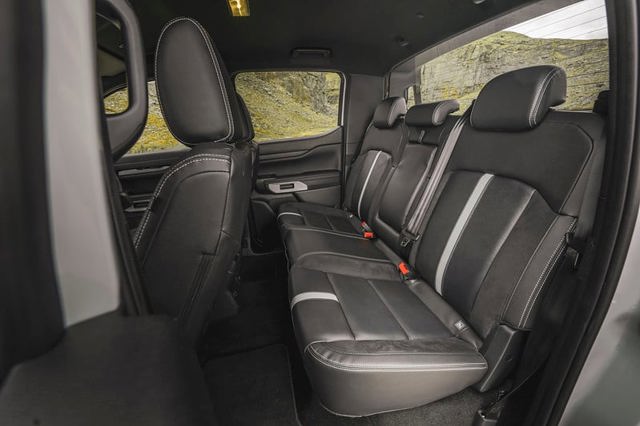
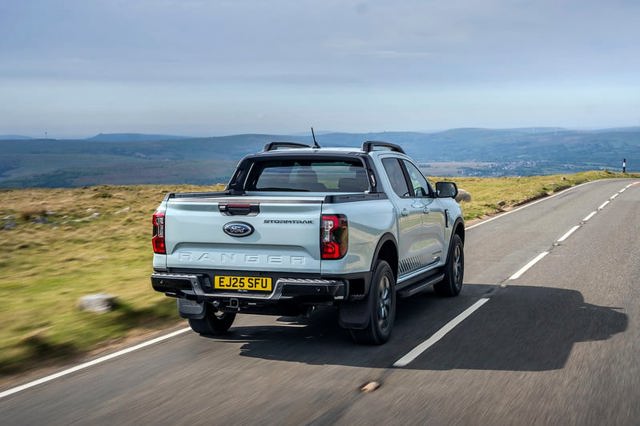
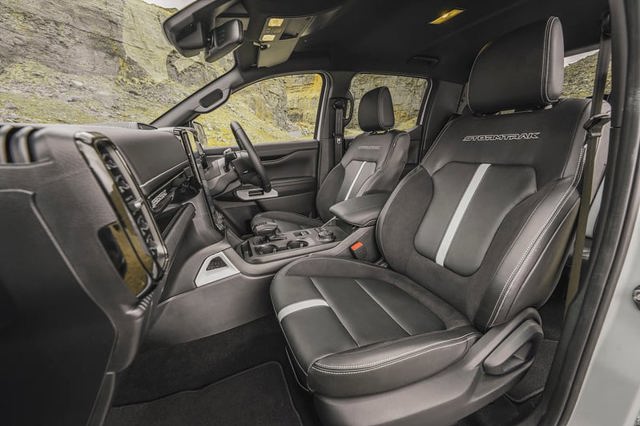
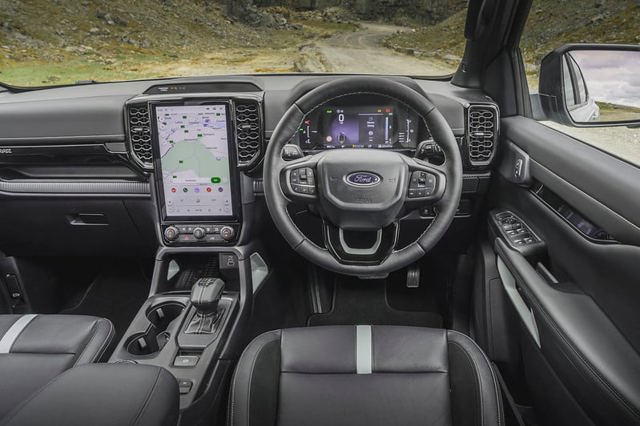
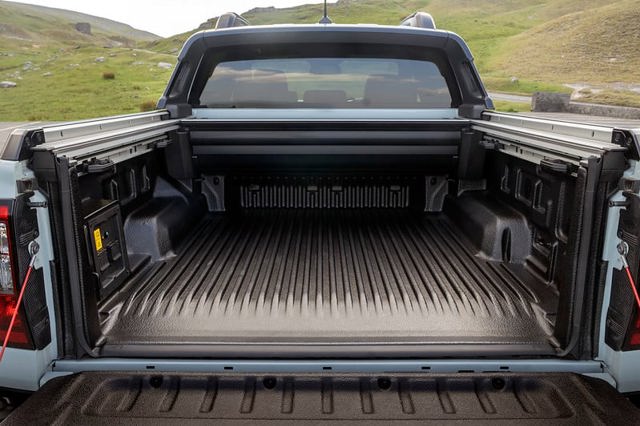
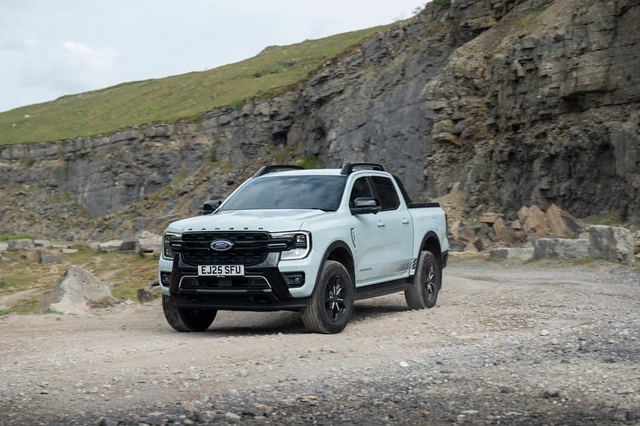
:no_upscale():format(webp)/https://cdn.uk.prod.group-mobility-trader.com/images/cas/9644cfddac158a766a513c8605d89198/73025cd9a3865e7b2d6a38925e546d8a.jpg)
 Striking styling. 3.5t towing capacity. Off-road ability. Unique — for now — as a PHEV pickup.
Striking styling. 3.5t towing capacity. Off-road ability. Unique — for now — as a PHEV pickup.
 Expensive to buy. Struggle to match official mpg figures in the real-world. Not available with cheapest trim level.
Expensive to buy. Struggle to match official mpg figures in the real-world. Not available with cheapest trim level.
:no_upscale():format(webp)/https://cdn.uk.prod.group-mobility-trader.com/images/cas/fed4b42d89c5fc847151068eeca640e1/2871ee68138197833ab36d5e603af6a4.jpg)
:no_upscale():format(webp)/https://cdn.uk.prod.group-mobility-trader.com/images/fallback/coming-soon.webp)
:no_upscale():format(webp)/https://cdn.uk.prod.group-mobility-trader.com/images/cas/5f0aac94c717902c1a4f6142b2309e68/5e9d642b906f417396ab0f8317f9f5fa.jpg)